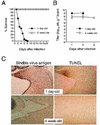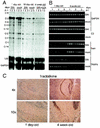Age-dependent resistance to lethal alphavirus encephalitis in mice: analysis of gene expression in the central nervous system and identification of a novel interferon-inducible protective gene, mouse ISG12
- PMID: 12388728
- PMCID: PMC136759
- DOI: 10.1128/jvi.76.22.11688-11703.2002
Age-dependent resistance to lethal alphavirus encephalitis in mice: analysis of gene expression in the central nervous system and identification of a novel interferon-inducible protective gene, mouse ISG12
Abstract
Several different mammalian neurotropic viruses produce an age-dependent encephalitis characterized by more severe disease in younger hosts. To elucidate potential factors that contribute to age-dependent resistance to lethal viral encephalitis, we compared central nervous system (CNS) gene expression in neonatal and weanling mice that were either mock infected or infected intracerebrally with a recombinant strain, dsTE12Q, of the prototype alphavirus Sindbis virus. In 1-day-old mice, infection with dsTE12Q resulted in rapidly fatal disease associated with high CNS viral titers and extensive CNS apoptosis, whereas in 4-week-old mice, dsTE12Q infection resulted in asymptomatic infection with lower CNS virus titers and undetectable CNS apoptosis. GeneChip expression comparisons of mock-infected neonatal and weanling mouse brains revealed developmental regulation of the mRNA expression of numerous genes, including some apoptosis regulatory genes, such as the proapoptotic molecules caspase-3 and TRAF4, which are downregulated during development, and the neuroprotective chemokine, fractalkine, which is upregulated during postnatal development. In parallel with increased neurovirulence and increased viral replication, Sindbis virus infection in 1-day-old mice resulted in both a greater number of host inflammatory genes with altered expression and greater changes in levels of host inflammatory gene expression than infection in 4-week-old mice. Only one inflammatory response gene, an expressed sequence tag similar to human ISG12, increased by a greater magnitude in infected 4-week-old mouse brains than in infected 1-day-old mouse brains. Furthermore, we found that enforced neuronal ISG12 expression results in a significant delay in Sindbis virus-induced death in neonatal mice. Together, our data identify genes that are developmentally regulated in the CNS and genes that are differentially regulated in the brains of different aged mice in response to Sindbis virus infection.
Figures





Similar articles
-
Identification of genes involved in the host response to neurovirulent alphavirus infection.J Virol. 2001 Nov;75(21):10431-45. doi: 10.1128/JVI.75.21.10431-10445.2001. J Virol. 2001. PMID: 11581411 Free PMC article.
-
Sindbis Virus Can Exploit a Host Antiviral Protein To Evade Immune Surveillance.J Virol. 2016 Oct 28;90(22):10247-10258. doi: 10.1128/JVI.01487-16. Print 2016 Nov 15. J Virol. 2016. PMID: 27581990 Free PMC article.
-
Fatal Sindbis virus infection of neonatal mice in the absence of encephalitis.Virology. 1996 Oct 1;224(1):73-83. doi: 10.1006/viro.1996.0508. Virology. 1996. PMID: 8862401
-
Age-dependent susceptibility to fatal encephalitis: alphavirus infection of neurons.Arch Virol Suppl. 1994;9:31-9. doi: 10.1007/978-3-7091-9326-6_4. Arch Virol Suppl. 1994. PMID: 8032263 Review.
-
The role of antibody in recovery from alphavirus encephalitis.Immunol Rev. 1997 Oct;159:155-61. doi: 10.1111/j.1600-065x.1997.tb01013.x. Immunol Rev. 1997. PMID: 9416509 Review.
Cited by
-
Expression quantitative trait Loci for extreme host response to influenza a in pre-collaborative cross mice.G3 (Bethesda). 2012 Feb;2(2):213-21. doi: 10.1534/g3.111.001800. Epub 2012 Feb 1. G3 (Bethesda). 2012. PMID: 22384400 Free PMC article.
-
Antiviral Activity of Interferon Alpha-Inducible Protein 27 Against Hepatitis B Virus Gene Expression and Replication.Front Microbiol. 2021 Mar 31;12:656353. doi: 10.3389/fmicb.2021.656353. eCollection 2021. Front Microbiol. 2021. PMID: 33868214 Free PMC article.
-
Recovery from viral encephalomyelitis: immune-mediated noncytolytic virus clearance from neurons.Immunol Res. 2010 Jul;47(1-3):123-33. doi: 10.1007/s12026-009-8143-4. Immunol Res. 2010. PMID: 20087684 Free PMC article. Review.
-
Immunopathogenesis of alphaviruses.Adv Virus Res. 2020;107:315-382. doi: 10.1016/bs.aivir.2020.06.002. Epub 2020 Jul 8. Adv Virus Res. 2020. PMID: 32711733 Free PMC article.
-
The role of innate versus adaptive immune responses in a mouse model of O'nyong-nyong virus infection.Am J Trop Med Hyg. 2013 Jun;88(6):1170-9. doi: 10.4269/ajtmh.12-0674. Epub 2013 Apr 8. Am J Trop Med Hyg. 2013. PMID: 23568285 Free PMC article.
References
-
- Allsopp, T. E., and J. K. Fazakerley. 2000. Altruistic cell suicide and the specialized case of the virus-infected nervous system. Trends Neurosci. 23:284-290. - PubMed
-
- Belloir, B., E. Kovari, M. Surini-Demiri, and A. Savoiz. 2001. Altered apolipoprotein D expression in the brain of patients with Alzheimer disease. J. Neurosci. Res. 64:61-69. - PubMed
-
- Bilbao, D., E. Guarin, P. Nef, P. Vallet, P. Giannakopoulos, and M. Dubois-Dauphin. 1999. Postnatal distribution of cpp32/caspase-3 mRNA in the mouse central nervous system: an in situ hybridization study. J. Comp. Neurol. 409:339-357. - PubMed
-
- Bittigau, P., M. Sifringer, D. Pohl, D. Stadthaus, M. Ishimaru, H. Shimizu, M. Ikeda, D. Lang, A. Speer, J. W. Olney, and C. Ikonomidou. 1999. Apoptotic neurodegeneration following trauma is markedly enhanced in the immature brain. Ann. Neurol. 45:724-735. - PubMed
-
- Denovan-Wright, E. M., G. R. Ferrier, H. A. Robertson, and S. E. Howlett. 2000. Increased expression of the gene for alpha-interferon-inducible protein in cardiomyopathic hamster heart. Biochem. Biophys. Res. Commun. 267:103-108. - PubMed
Publication types
MeSH terms
Substances
Grants and funding
LinkOut - more resources
Full Text Sources
Other Literature Sources
Medical
Molecular Biology Databases
Research Materials

